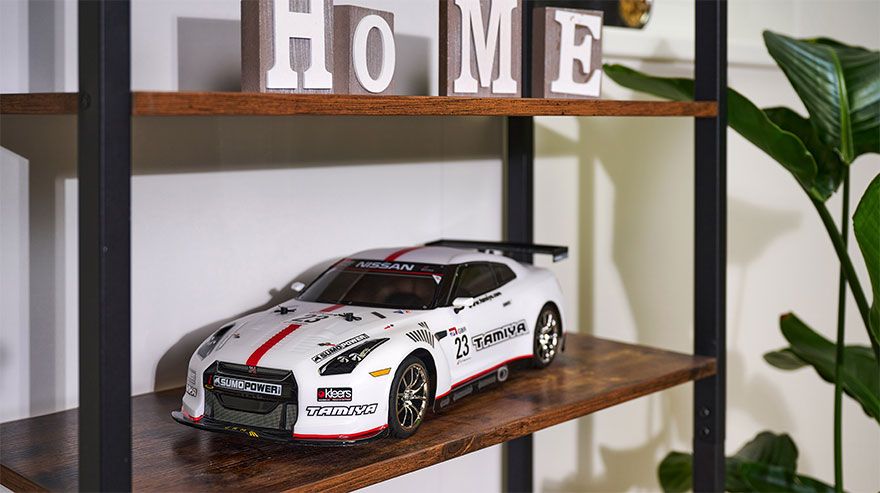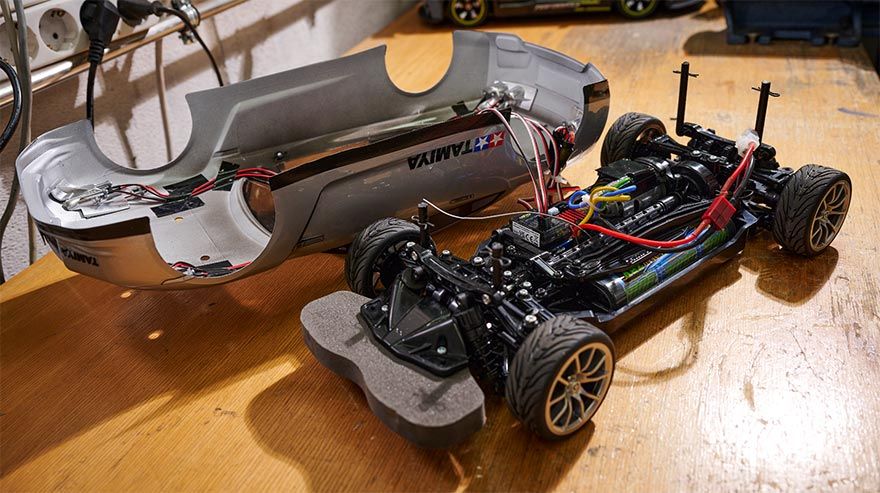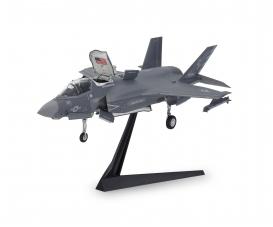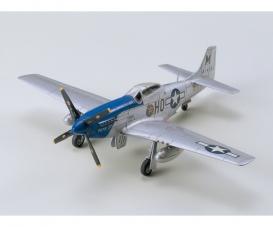Model aircraft kits 1:72
Discover the world of aeroplanes in a handy size with our 1:72 scale models! These compact but detailed replicas offer you the opportunity to recreate historical and modern aeroplanes with precision. Perfect for modelling fans who appreciate attention to detail in a small space!

Model aircraft kits 1:72
1:72 Mitsubishi A6M2b Zero (Zeke)
300060780€27.99
Article number: 300060780 Product: 1:72 WWII Mitsubishi A6M2b Zero (Zeke) From the early days of the Second Sino-Japanese War to the end of hostilities in the Pacific, the Mitsubishi Zero served as the Imperial Japanese Navy's main frontline fighter. The first major mass-produced version was the A6M2b, which was equipped with 50cm folding wingtips, landing hook, and radio direction finder for carrierbased operations. Flown by expert pilots, the A6M2b took part in daring operations such as the Pearl Harbor attack and the invasion of the Philippines. It's 3,000km range, powerful 20mm cannon armament, and legendary maneuverability quickly earned the respect of Allied aircrews. The Tamiya model assembly kit faithfully reproduces this historic warplane in 1/72 scale. About the model - 1/72 scale plastic assembly kit. - New tooling for wing, fuselage, and engine cowling. - Wing is depicted in extended position only. - One-piece engine cowling via slide molding manufacturing process. - Detailed cockpit and landing gear wells. - Comes with 3 decal marking options to depict aircraft that took part in the Pearl Harbor Attack. Warning! Not suitable for children under 14 years.
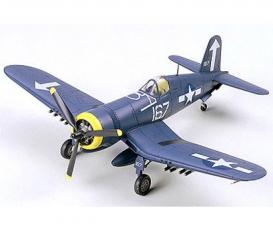
Model aircraft kits 1:72
Vought F4U-1D Corsair
300060752€21.49
Article number: 300060752 Product: 1:72 Vought F4U-1D Corsair Designed around the new Pratt & Whitney 2,000HP radial engine and tuning the largest propeller ever attached to a fighter plane, the Vought F4U Corsair became a legend in its own time. The F4U-1 was the first production version of the Corsair. It had an inverted gull wing and a production version of the Corsair. It had an inverted gull wing and a framed canopy with a flat top. However may problems were found soon. For example, the port wing stall often gave the Corsair unstable landing. Anther problem was poor visibility because of its long nose and framed canopy. Therefore F4U-1A: the cockpit was raised about seven inches, the framed canopy was replaced with a semi-bubble design canopy, and the taller tail wheel strut was equipped; was introduced. F4U-1D with clear vision canopy on frameless was introduced later for more visibility. Also the F4U-1D had two pylons under the center wing section that could carry the bombs up to 1,000 ponds and the napalm. Furthermore 5 inch rockets could be carried under each wing. Therefore in1944, the F4U-1D was formally deployed as the first carrier based aircraft of Corsair series. Beginning by placing the F4U 1D as Marine squadrons VMF-124 and VMF 213 aboard the ESSEX on the way to the Phillippines, the F4U-1D was used for attacking Japan as the first operation from U.S. Navy in 1945. About 3,700 amounts of F4U-1D were produced, then it held an established position from U.S. Navy because of its ability and reliance. Detailed Plastic Kit of model Vought F4U-1D Corsair in scale 1:72 Warning! Not suitable for children under 14 years.
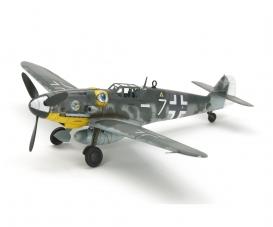
Model aircraft kits 1:72
1/72 Bf-109 G-6 Messerschmitt
300060790€26.99
Article number: 300060790 Product: 1/72 Bf-109 G-6 Messerschmitt In great news for modelers in the compact 1/72 scale, the "Gustav" is to be released as a Tamiya kit! With over 30,000 produced, the Messerschmitt Bf109 is the most prolifically manufactured fighter in history; of its variants, the G-6 was the most numerous at 13,000 aircraft. In response to improving Allied foes in the air, Bf109 G aircraft had the more powerful DB605 engine, and from the G-6 were equipped with dual 13mm MG131 machine guns that required the distinctive bulges on either side of the cockpit cowling known as "Beule." Some were even given a 20mm cannon gondola under each wing for further improved firepower. The Bf109 G-6 was deployed on both the Western and Eastern fronts, in particular dominating Soviet adversaries as it continued in service through to the end of WWII. About the Model - This is a 1/72 scale plastic model assembly kit. - The striking, refined form of the G-6 variant Bf109 is captured, including depictions of the Beule bulges. - This product takes inspiration from the highly accurate 1/48 model (Item 61117). Please note that engine cowlings are depicted closed. - The cockpit is inserted after left and right fuselage halves have been put together. It has an accurate interior with streamlined assembly. - Canopy can be assembled in open or closed state. - Landing gear struts have a solid attachment point for accurate attachment angle and position. - Comes with optional drop tank parts. - 2 marking options are planned - JG51 (with distinctive eye marking on the Beule) and JG54. Detailed Plastic Kit
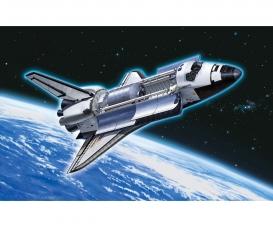
Model aircraft kits 1:72
1:100 Space Shuttle Atlantis
300060402€66.99
Article number: 300060402 Product: 1/100 Space Shuttle Atlantis NASA's space shuttle was first launched on April 12, 1981 and the fleet has accomplished numerous historic missions throughout their 30 years of service. The spacecraft conducted the latest research and played an important role in building the largest structure in space thus far, the International Space Station. The final space shuttle mission ended on July 21, 2011 with the flight of the Atlantis and the shuttle fleet is now destined for public display in museums across the United States. Warning! Not suitable for children under 14 years.
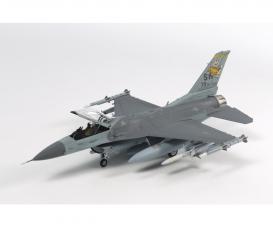
Model aircraft kits 1:72
1:72 F-16CJ w/FULL EQUIPMENT
300060788€42.99
Article number: 300060788 Product: 1/72 F-16CJ w/FULL EQUIPMENT This is the second release of the 1/72 scale F-16CJ [Block 50] Fighting Falcon (original Tamiya release: Item 60786) now with parts depicting underside equipment used on the aircraft! The versatile F-16 Fighting Falcon's adaptability to both air-to-air and air-to-ground missions makes it one of the cornerstones of the U.S. Air Force today. Block 50 evolutions of the aircraft were deployed from 1991, F-16CJ fighters being fitted with radar countermeasures. The aircraft's capabilities were extended yet further via the CCIP program, which gave night fighter functionality and more. Equipment depicted using new parts Centerline fuel tank Wing underside fuel tanks ECM counter measures pod AGM-88 HARM missiles AN/ASQ-213 HTS targeting pod AIM-120 AMRAAM missiles AIM-9M & -9X Sidewinder missiles AN/AAQ-33 Sniper XR pod Warning! Not suitable for children under 14 years.
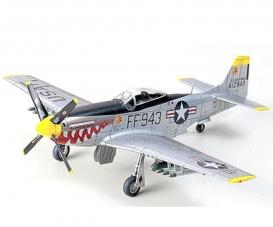
Model aircraft kits 1:72
1:72 F-51D Mustang North American
300060754€15.99
Article number: 300060754 Product: 1:72 F-51D Mustang North American Sketched out in a New York city hotel in April 1940, the North American Aviation Corporation NA73X went on to become one of the best fighters to come out of World War 2. The U.S. Army Air Corps gave it the title of P (for Pursuit) 51, and it was named Mustang by the British. Of the several variations of the Mustang, the P-51D is considered the definitive version and was the first to have the bubble canopy. More "D" models were built than any other variant, with a total of 9,603 being produced. Armed with six .50 caliber machine guns, three in each wing, with 400 rounds for each inboard gun and 270 rounds for the other four, plus underwing pylons for auxiliary fuel tans or 1000lb bombs, the Mustang was a true fighter pilots airplane. At the conclusion of WW2, Mustangs were in operation all over the world, flying in several nations air forces. When the Korean conflict broke out, hundred of F (for fighters) 51's were in Japan awaiting scraping. Because they possessed too slow speed maneuverability that was absent in the new jets then entering service, the F-51 was ideal to work with Forward Air Controllers (FAC's) on the ground in Korea. The major drawback to this was the F-51's liquid cooled engine susceptibility to anti aircraft and small arms fire when attacking ground targets. This caused the Mustang to have the highest loss ratio of any aircraft in Korea. A total of 194 were lost in three years, with only 10 being downed in combat with other aircraft. Detailed Plastic Kit of model North American F-51D Mustang in scale 1:72 Warning! Not suitable for children under 14 years.
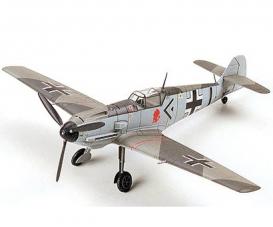
Model aircraft kits 1:72
1:72 Ger. Messerschmitt Bf109E-3
300060750€15.99
Article number: 300060750 Product 1:72 Ger. Messerschmitt Bf109E-3 Without a doubt, the Messerschmitt Bf109 can be clamed as the most famous and successful German aircraft from the WW2. It was the world´s most advanced fighter at that time of its debut in 1936, and remained as the standard fighter for the Luftwaffe throughout the conflict. Created by the brilliant designer Willi Messerschmitt, it had the smallest possible air frame built around the most powerful engine available. It also boasted many of the then innovated features such as an all metal stressed skin construction, retractable main landing gear. Automatic Handley-Page leading edge slats, etc. The Bf109 saw the first combat during the Spanish Civil War and fully demonstrated it exceptional maneuverability, inherited from its precedent Bf108 Taifun (Typhoon) multi-purpose sports plane. The Bf109 underwent numerous improvements throughout its carrier, and mass production of the E variant started late in 1939. Within one year, about 2,000 "E" aircraft were rolled out. Its excellent performance greatly contributed in the active service of German pilots at the Western Front and during the "Battle of Britain". The E-3 version used and improved Daimler-Benz DB601Aa engine capable of 1,100 h.p. output. This engine had provision for mounting a 20mm MG FF cannon on the crankcase and firing through propeller hub. The Messerschmitt Bf109E was one of the best fighters of the early WW2 period, on a par with the British Spitfire. Detailed Plastic Kit of model Messerschmitt Bf109E-3 in scale 1:72 Warning! Not suitable for children under 14 years.

Model aircraft kits 1:72
1:72 Jap. Mitsubishi A6M5 Zero Fighter
300060779€23.49
Article number: 300060779 Product: 1:72 Jap. Mitsubishi A6M5 Zero Fighter This is the definitive 1/72 plastic model of the Japanese Navy's representative fighter aircraft, the Mitsubishi A6M5 Zero Fighter. History of the Zero fighter: The Mitsubishi A6M Zero was the Japanese Navy's main fighter throughout the Pacific Theater during WWII. In the latter half of the war, the model 52 Zero, a refined version of the model 22, aimed to take on the ever increasing numbers of high-performance U.S. aircraft. It featured a shorter 11m wingspan with rounded wingtips, was powered by the same 1130hp Nakajima "Sakae" engine as seen in the model 22 Zero, and had the new exhaust propulsion system which gave it a 565km/h top speed. The A6M5 came armed with two 7.7mm machine guns and 20mm belt-fed cannons. Deployment of the A6M5 began in the autumn of 1943, and they saw action in the Solomons campaign as well as over the Marianas. It defended Japan against overwhelming numbers of superior U.S. aircraft up until the very last day of the war.
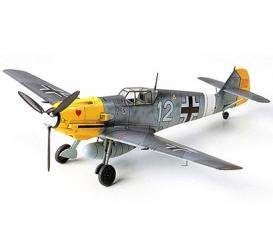
Model aircraft kits 1:72
1:72 ME-BF 109E-4/7 TRUP
300060755€17.29
Article number: 300060755 Product: 1:72 ME-BF 109E-4/7 TRUP During the first half of the Second World War, the Messerschmitt Bf109 E was the main fighter of the German airforce. The E-4 housed a 1,100hp Daimler Benz DB 601Aa engine and was armed with two 7.92mm machine guns on the nose, as well as a 20mm cannon on each wing. For some aircraft, bullet-proof glass was used to reinforce the front of the canopy. In addition, a 20mm canon, which ran through a tube in the propeller was supposed to be installed but was unsuccessful. Displaying superb acceleration and diving ability, the E-type planes overpowered the RAF's Hawker hurricane and equaled the Spitfire fighters in the Battle of Britain. However, with a flight range of only 560km, the E-4 planes were limited to just fifteen minutes of combat over British skies. Thus, the bombers were not given sufficient support and sustained heavy damage. As a result, the Luftwaffe's strategy to bomb England into surrender ended in failure. To deal with this drawback, the E-4 planes were equipped with additional 300L fuel tank. These improved fighters, called E-7, were first deployed at the end of 1940. After the Battle of Britain, the E-4/7 planes were sent to the front lines of Northern Africa. As the Bf109 F-type fighter's production was advanced, the E-4/7 was retired from the front lines. However, some veteran pilots continued to use the E-4/7 mainly for ground support duty until the summer of 1942. Bf109E-4/7 TROP Warning! Not suitable for children under 14 years.
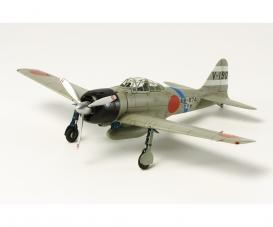
Model aircraft kits 1:72
1:72 Mits. A6M3 Zero Fighter Mo. 32 Hamp
300060784€21.99
Article number.: 300060784 Product: 1:72 Mits. A6M3 Zero Fighter Mo. 32 Hamp The 1/72 scale Warbirds Collection welcomes the A6M3 Zero fighter Model 32, which was codenamed ‘Hamp’ by American forces. The Model 32 was an evolution of the Model 21; it received an improved Sakae 21 engine and shorter, redesigned main wing, with the effect that its top speed increased by 11km/h and it also had improved roll and diving speed, albeit at the cost of increased fuel consumption. In fact, this plus with the Model 32’s smaller fuel tank meant its range was some 1,000km shorter. The Model 32 made its maiden flight on July 15th 1941, and first saw service with the 2nd Fighter Group in Rabaul, the Philippines. All told, 343 Model 32 aircraft were manufactured, a number so low in part due to the range limitations of the aircraft. About the Model • This is a 1/72 scale plastic model assembly kit. • The model faithfully replicates the form of the A6M3 Zero Model 32 with square-shaped wings. • Main wing, fuselage, and engine cowl are all newly-designed parts. • Features such as flaps integrated with wing parts make this model easy to build while still retaining an excellent grasp of the aircraft’s details. • 3 sets of markings included.

Model aircraft kits 1:72
1:72 Supermarine Spitfire Mk.I
300060748€15.99
Article number: 300060748 Product: 1:72 SUPERMARINE SPITFIRE MK1 The Supermarine Spitfire is regarded by many as the most esthetically designed single seat fighter to appear during the Second World War. It was conceived by the brilliant British designer Reginald J. Mitchell, and first flew on 5 March 1936. It was an advanced, low wing single seat monoplane with a very smooth flush riveted metal skin and a long flowing front cowling. Using the famous RollsRoyce "Merlin' liquid cooled 12 cylinder engine that produced more than 1,000 horsepower, the Mk I Spitfire attained a top speed of 586km/h. The very distinctive elliptical shaped wing was useful in reducing parasitic drag and allowed a fairly thin wing construction. It carried a large coolant radiator under the starboard wing, and a small oil cooler under the port wing, giving it an asymmetrical appearance when viewed from the front and bottom. The retractable main landing gear also contributed to its smooth lines, and gave it higher performance. The Mk I Spitfire was armed with eight 7.7mm machine guns, four to each wing. The early production of Mk I Spitfires used a fixed pitch wooden two blade propeller, which was later replaced with a two-pitch wooden two blade propeller. The Spitfire's combat action in thwarting Germany's attempt to raid the English mainland during 1940, and known as the "Battle of Britain" has ensured this fighter's pride of place in the minds of England's men and women forever. Supermarine Spitfire Mk.I Warning! Not suitable for children under 14 years.

Model aircraft kits 1:72
1:72 US F-16CJ Fighting Falcon
300060786€30.99
Article number: 300060786 Product: 1:72 US F-16CJ Fighting Falcon The Lockheed Martin F-16 Fighting Falcon is a single-engine multirole fighter aircraft originally developed by General Dynamics for the United States Air Force (USAF). It was designed as an air superiority day fighter and later it evolved into a successful all-weather multirole aircraft. As of 2012, over 4,500 aircraft have been built since production was approved in 1976. In 2004 and in 2008 Tamiya’s model designers captured this iconic fighter in 1/48 scale and in 1/32 scale respectively, which both models received tremendous accolades from the modeling community and the industry press. The third release continues Tamiya’s tradition of excellence with this 1/72 cale model. This version is specifically of the F-16CJ (Block50) and it shares some of the same level of details as its larger counterparts. It is the perfect scale model for modelers confined to smaller display areas to show off their hard modeling work.
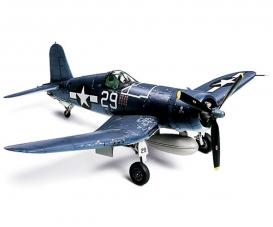
Model aircraft kits 1:72
1:72 Vought F4U-1A Corsair
300060775€24.49
Article number: 300060775 Product: 1/72 Vought F4U-1A Corsair About the Vought F4U-1A Corsair Introduced into service in 1942, the Vought F4U-1 featured inverted gull wings and a massive 2,000hp engine spinning the largest propeller mounted on a fighter at the time. While the fighter's performance and toughness was quite impressive, deficiencies such as inadequate forward visibility, restricted all-round visibility due to the early frame-like canopy, and the tendency for the left and right wings to stall at different speeds led to various improvements being added throughout production, eventually resulting in the F4U-1A version. These improvements included a longer tailwheel leg for better forward visibility, a new canopy for better all-round visibility, and an almost unnoticeable 15cm stall strip fixed to the leading edge of the right wing to ensure both wings would stall at the same speed. About the Model •1/72 scale assembly model kit of the Vought F4U-1A Corsair •Kit depicts a final F4U-1A Corsair production version with all improvements or versions at different stages of the improvement process. •Parts for 1000lb. bomb, external fuel tank, two types of propellers, and two types of tailwheel are included to provide many modelling possibilities •High quality decals for 3 different sets of markings Vought F4U-1A Corsair Warning! Not suitable for children under 14 years.

Model aircraft kits 1:72
De Havilland Mosquito FB Mk.VI
300060747€23.49
Article number: 300060747 Product: De Havilland Mosquito FB Mk.VI The De Havilland "Mosquito" made of wood was designed based on "high-speed bomber shaking off fighter". The design of the Mosquito was got in shape in 1939. The De Havilland had experienced producing "DH88 Comet" made of wood before, therefore they paid attention that the surface of wooden wing could be finished smoothly and the amount of aluminum could be saved. Two of Rolls Royce Merlin engines were selected as the source of power and the wood was used as the material of this fuselage. The parts with the metal were only the parts of the periphery of the engine and the landing gear. At the first time, the Air Ministry was passive adopting the Mosquito because of wooden and no machine guns. However the Mosquito made a maiden flight with the maximum speed of 630km when the "Spitfire" had the maximum speed of 580km at those time. Therefore a lot of "Mosquito" were suddenly requested. After many types of the Mosquito were produced, Night-Fighter Mk. II armed with 7.7mm machine guns on its nose and A.I.Mk.IV radar made an appearance. This Mosquito brought its ability into full play in attacking an airfield and intercepting raiding bombers. Also Fighting Bomber Mk. VI armed with four 225kg bombs and eight of rocket bombs was arranged as the actual fighting in Mar. 1943. This type played havoc with theland forces, the battleships and the U-boat. Furthermore it was active in attacking the railroad and its bridge at Burmese front line, giving a blow to Japanese army. The mosquito's wooden structure was strong against being shot, therefore it held an established position from the pilots with the special mission. Detailed Plastic Kit of model De Havilland Mosquito FB Mk.IV in scale 1:72 Warning! Not suitable for children under 14 years.
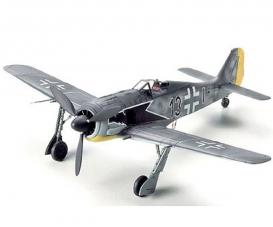
Model aircraft kits 1:72
Focke-Wulf Fw190 A-3
300060766€15.99
Article number: 300060766 Product: Focke Wulf Fw 190 A-3 Development of the FW190 series began in the Autumn of 1937, under a contract issued by the Reichsluftfahrtministerium (Air Ministry) for a single seat fighter to supplement the Messerschmitt Bf109. Two proposals were submitted by Kurt Tank, the technical director of the Focke-Wulf Flugzeugbau (aircraft factory). The proposal using the then new BMW 801 aircooled radial engine was chosen. This tough and powerful engine was placed in a robust airframe and provided superb handling, well balanced control, and brisk acceleration. It entered service in 1941, flying alongside the Bf 109 and it soon took control of air superiority over the English Channel. Establishing itself as a mainstay fighter of the Luftwaffe, it outperformed the contemporary Spitfire Mk.V's in almost every respect and maintained this advantage until the arrival of the Spitfire IX in July 1942. The Fw190 fighter underwent constant improvement throughout its life. The A-3 version used the improved BMW 801Dg engine that produced 1,700hp. Armament was increased from four to six guns, consisting of two rapid firing MG151's in the wing roots; two MG FF's outboard of the landing gear and two fuselage mounted MG 17 machine guns. Throughout WW2, many Luftwaffe squadrons allowed personal pilot markings and distinctive squadron insignia to be used, plus lower cowl, wing tip and rudder color additions to the original paint schemes. Detailed Plastic Kit of model Focke Wulf Fw 190 A-3 in scale 1:72 Warning! Not suitable for children under 14 years.

Model aircraft kits 1:72
Kawanishi Shiden Type 11
300060768€14.79
Article number: 300060768 Product: 1/72 Kawanashi Shiden Type 11 Evolving from the Kawanishi N1K1 "Kyofu" floatplane, the Imperial Japanese Navy's N1K1-J Shiden had a unique pedigree amoung WW2 landplane fighters of the world. In January 1942, the Kawanishi Aircraft firm began adaptation of the Kyofu into a land based fighter, strictly as a private venture. This project was soon officially authorized under the designation N1K1-J, with the first prototype flying in December 1942. The airframe was basically the same as its predecessor, with main landing gear and tall wheel replacing the floats. In place of Kyofu's Mitsubihi Kasei engine, a more compact and powerful Nakajima Homare engine was installed. Excellent performance and superb maneuverability was achieved using this engine, however it brought about serious problems. In order to use all of the available power in the engine, a large diameter propeller was required. This required unusually long main landing gear legs, because of the midwing configuration. This caused difficulties in the landing gear retraction system. Kawansihi engineers managed to solve the problem by introducing telescopic main landing gear legs. The complex gear system and unreliability of the engine, plagued the N1K1-J throughout its career, until the introduction of the improved, low-wing N1K2-J Shiden-Kai. About 1,000 N1K1-J fighters were produced and were active around the Phillipine islands, Formosa, Okinawa and over the Japanese Island of Honshu. Detailed Plastic Kit of model Kawanashi Shiden Type 11 in scale 1:72 Warning! Not suitable for children under 14 years.
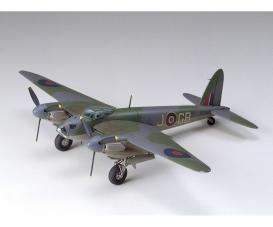
Model aircraft kits 1:72
Mosquito B Mk.IV/PR Mk.IV
300060753€23.49
Article number: 300060753 Product: 1:72 Mosquito B Mk.IV/PR Mk.IV The versatile Mosquito stood with the Spitfire fighter and Lancaster bomber and earned the respect of British pilots during World War II. In 1939, the De Havilland company envisioned the plane to be an unarmed high speed bomber, and had experience with the Comet, which was a wooden racing plane. Except for the engine and landing gear, the Mosquito was comprised of wood, offering strategic advantages. The wooden construction wold save on important metals such as aluminum, it could also be built in converted furniture factories. The Air Ministry was reluctant to adopt the wooden aircraft, but placed orders for 50 planes in March 1940 for reconnaissance use. In November 1940, the Mosquito reached speeds of 630km/h during test flights, demonstrating its potential and quickly prompting additional orders of 150 planes. The Mosquito PR Mk. I reconnaissance plane was first deployed in July 1941; the B Mk. IV bomber started deployment in the Spring of 1942. On May 31, 1942, the Mosquitoes led a daylight raid on Cairn. In September 1942, the Gestapo headquarters in Oslo was bombed. German officials delivering a daytime speech in Berlin were attacked on January 30, 1943. These events demonstrated the Mosquito's ability to carry heavy loads and deliver low altitude surprise attacks with accuracy. The camera equipped PR Mk. IV reconnaissance plane discovered the German Battleship Tirpitz in the Artic Circle and scouted V2 rocket facilities. The Mosquitoes performced their duties with minimal losses, displaying their remarkable abilities. Detailed Plastic Kit of model Mosquito B Mk.IV/PR Mk.IV in scale 1:72 Warning! Not suitable for children under 14 years.

Model aircraft kits 1:72
P-47D Thunderbolt Bubbletop
300060770€21.99
Article number: 300060770 Product: 1/72 P-47D Thunderbolt Bubbletop About the P-47D Thunderbolt One of the most famous planes of WWII, the P-47D Thunderbolt was an outstanding single seat fighter plane excelling in high-altitude bomber escort and low-altitude ground attack. The P-47D featured a turbo-supercharged engine and was active on both the European and Pacific fronts. To solve the problem of insufficient visibility of earlier models, later Thunderbolt models were redesigned with a transparent bubble canopy, leading to the birth of the "Bubbletop". About the Model •Following the successful release of the P-47D "Razorback", Tamiya now introduces its successor, the "Bubbletop" to the 1/72 scale War Bird Collection. •At just 153mm it is the perfect size for collecting •Fuselage and canopy designed with all new parts to accurately represent bulky size •Loads of accessories including 500 pound bombs and M10 rocket launchers •Decals for 2 types of markings, including the 8th Air Force, 78th Fighter Group. Warning! Not suitable for children under 14 years.

Model aircraft kits 1:72
P-47D Thunderbolt Razorback
300060769€21.99
Article number: 300060769 Product: 1/72 P-47D Thunderbolt Razorback The P-47 was the first single-seated fighter to be equipped with a supercharger paired with a 2000hp engine, allowing it to fly at the same high altitude as bombers. Armed with eight 12.7mm machineguns, the Thunderbolt, with the P-51 Mustang, constituted the main fighters of the US Army Air Force. This is the representation of P-47D early production that was nicknamed "razorback" because of the shape of its upper fuselage behind the cockpit. The P-47D was a high-speed, high-altitude capable fighter and escorted the allied bombers that were conducting raids over Germany. Its 1-ton payload and its robustness made the Thunderbolt the perfect aircraft for ground attacking missions. About the Model •Sharp design of rear fuselage accurately reproduced. •Unique belly shape perfectly replicated thanks to left-right symmetrical construction. • Joining beams used to attach wings to fuselage, ensuring accurate wing angle. •Loads of accessories including 2 x 108 gallon tanks, 2 x 500 pound bombs and 2 x M10 rocket launchers. •For extra accuracy, kit comes with two different propellers to match decal markings. •Decals for 2 fighter groups, including one from Europe and one from the Pacific. Warning! Not suitable for children under 14 years.
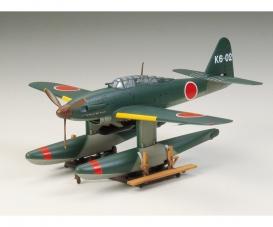
Model aircraft kits 1:72
SEIRAN
300060737€13.99
Article number: 300060737 Product: 1:72 SEIRAN This is a plastic model assembly kit of the Japanese Navy's special attacking machine, Harumi, developed for an unprecedented strategy of starting from catapult of a large submarine and launching a surprise attack. Faithfully reproduced a unique style fitted with a tightened nose or twin float equipped with an air-cooled engine. 800kg Movement dollies are also convenient for bombs and exhibitions. I printed a decal for the machine number of 6 aircraft. It would be interesting to explore the sunny storm that ended the war before the actual battle participation, by modeling its unknown ability. Detailed Plastic Kit of model SEIRAN in scale 1:72 Warning! Not suitable for children under 14 years.

Model aircraft kits 1:72
Skyray
300060741€14.49
Article number: 300060741 Product: 1/72 Skyray Towards the end of World War II, many information about advanced aeronautical technology were captured in Germany by the U.S. Forces. One of them was an analysis of the studies carried out by Dr. Alexander Lippisch on delta winged aircraft. Based upon the information, the Douglas firm developed the F4D Skyray, the only operational interceptor with delta wings in the U.S. Navy. Starting the design in 1947, Douglas was awarded a contract for the construction and testing of two prototypes in December 1948. The first prototype took off on its maiden flight in January 1951. The second prototype flew shortly thereafter, and the airframe set two new world records, absolute speed record of 1,211 km/h and 100km closed course record of 1,171km/h, in October 1953. Having numerous improvements and refinements, the first production F4D-1 made its maiden flight in June 1954 and entered squadren service in April 1956. The distinctive 50 degree sweptback wings with round tips were equipped with leading edge slats and trailing edge elevons. A set of trimmers were installed on the inboard trailing edges of the wings. The outer portions of the wings could be folded upwards by oil pressure for carrier stowage. Although the Skyray never saw any combat, it proved its high capability as an interceptor with numerous world records and scramble actions in Taiwan in response to crises in the late 1950's. Detailed Plastic Kit of model Skyray in scale 1:72 Warning! Not suitable for children under 14 years.
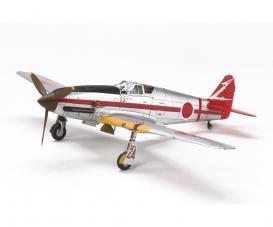
Model aircraft kits 1:72
1:72 Ki-61-Id Hien
300060789available in stores
Article number: 300060789 Product: 1:72 Ki-61-Id Hien This scale plastic model kit accurately depicts the Kawasaki Ki-61-Id Hien. The Hien was officially adopted by the Imperial Japanese Army in 1943, and stood out among its Japanese aircraft contemporaries in the Pacific War on account of its liquid-cooled Ha-40 engine, slimline fuselage and long, elegant wing. A number of different variants were produced, among them the Ki-61-Id which featured a 20cm-elongated nose to house 20mm cannons, plus 12.7mm machine guns in the wing. In fact, with 1,360 units it was the most prolifically produced Hien variant; its superior performance at higher altitudes meant that it was often given the brief of taking on incoming U.S. B29 bombers in the skies around the home islands of Japan.














